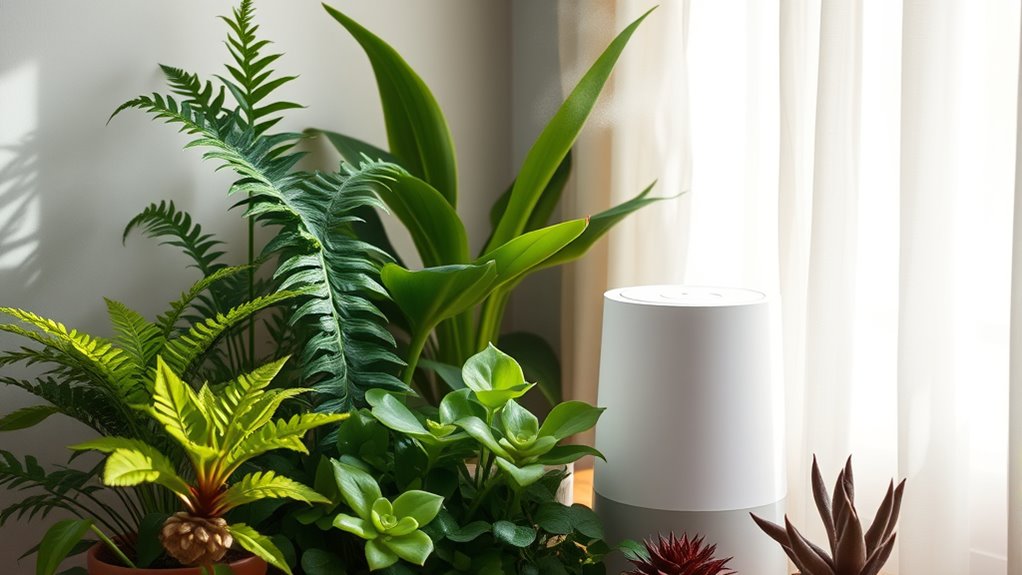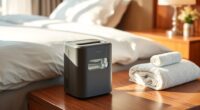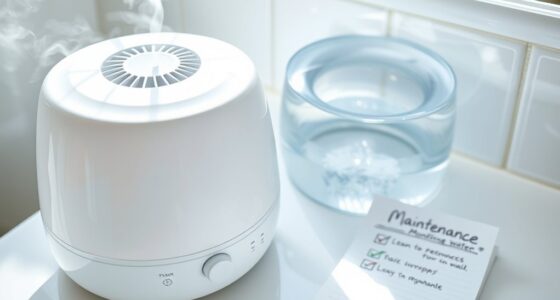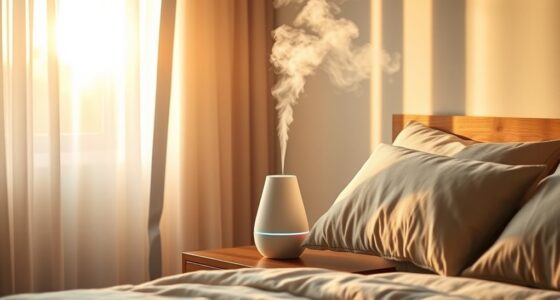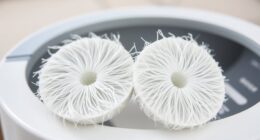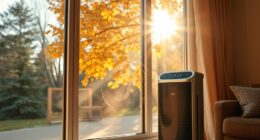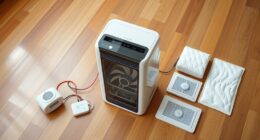Using a humidifier can turn your home into a lush indoor oasis by maintaining ideal humidity levels between 40% and 60%. This supports your houseplants’ health, making their foliage vibrant and resistant to pests. It also improves air quality by reducing dust and pollutants, creating a more comfortable environment for you. Proper placement and consistent maintenance ensure the best results. Keep exploring to discover how combining these tips can transform your space into a thriving, healthy haven.
Key Takeaways
- Use humidifiers near houseplants to maintain optimal humidity (40-60%) and promote healthy growth.
- Position humidifiers properly to ensure even moisture distribution without directly on plants.
- Regularly monitor humidity with a hygrometer to prevent over- or under-humidifying.
- Combine humidifier use with proper watering and good air circulation for a thriving indoor oasis.
- Keep humidifiers clean to prevent mold, bacteria, and fungal issues that could harm plants and air quality.
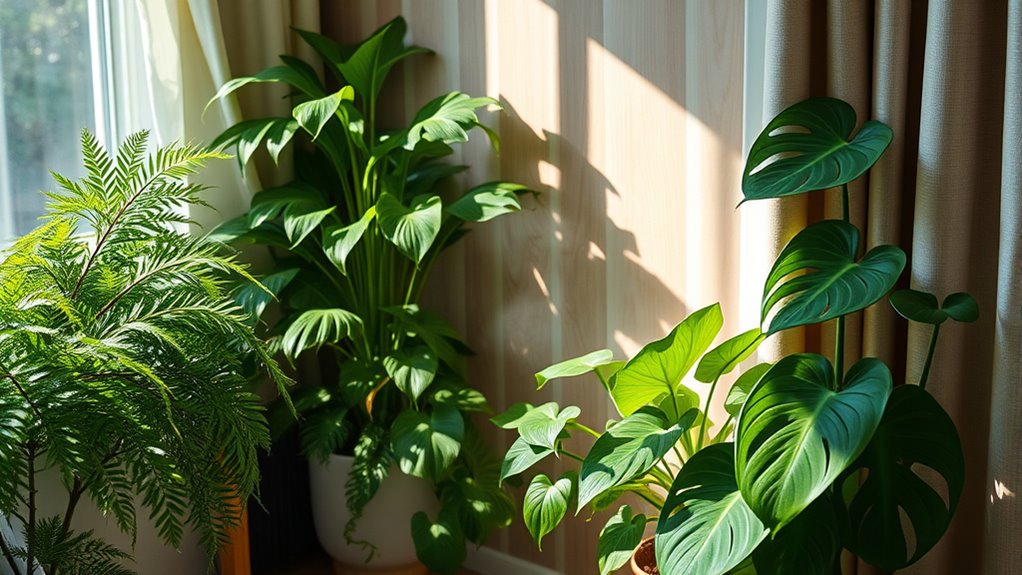
Have you ever wondered how to create a healthier indoor environment for both your houseplants and yourself? The secret lies in understanding how humidity levels influence plant health and air quality. Proper humidity not only helps your plants thrive but also improves the air you breathe. When indoor air is too dry, plants can become stressed, leading to wilting, browning leaf tips, and increased vulnerability to pests and diseases. At the same time, dry air can cause respiratory discomfort or dry skin for you. By adding a humidifier, you can strike a balance that benefits both, creating a mini indoor oasis.
Creating a healthier home environment with balanced humidity benefits both your plants and your well-being.
A humidifier works by releasing moisture into the air, raising humidity levels to a more ideal range — typically between 40% and 60%. This range is perfect for most houseplants, which prefer slightly humid conditions similar to their natural environments. When humidity is maintained within this range, your plants will experience less stress, grow more vigorously, and display vibrant, healthy foliage. Additionally, increased moisture in the air can help reduce dust and pollutants, leading to better air quality overall. Better air quality means fewer airborne allergens and irritants, which can make your living space more comfortable and healthier for you and your family. Creating a balanced humidity level also supports plant immunity, helping your houseplants resist common pests and diseases more effectively.
To maximize plant health and air quality, position your humidifier correctly. Keep it near your houseplants, but not directly on top of them, to ensure even distribution of moisture. Regularly monitor the humidity levels with a hygrometer, so you know exactly when to add more moisture to the air. Over-humidifying can lead to problems like mold growth or fungal issues on your plants, so moderation is key. Clean your humidifier frequently to prevent mold and bacteria buildup, which could negate the benefits by spreading spores or pollutants into the air.
Pairing a humidifier with proper watering routines and good air circulation creates an environment where plants can flourish. When your plants are healthier, they can improve air quality by absorbing carbon dioxide and releasing oxygen, and some even filter out toxins. This synergy enhances the overall atmosphere of your home, making it feel fresher and more inviting. Remember, the goal isn’t just to make your houseplants happy but to cultivate a space that promotes better breathing and well-being for everyone. Small adjustments like using a humidifier can have a big impact on creating a balanced, vibrant indoor sanctuary.
Frequently Asked Questions
Can Humidifiers Help Prevent Common Houseplant Pests?
Humidifiers can help prevent common houseplant pests by maintaining proper humidity levels, which promotes plant health and resilience. When humidity and pest control are balanced, plants are less stressed and less vulnerable to pests and plant diseases. While humidifiers aren’t a cure-all, they support plant wellness and reduce pest infestations, making them a useful tool in your overall plant care routine for disease prevention and pest management.
What Is the Ideal Humidity Level for Different Houseplants?
Think of your houseplants as delicate dancers, each needing a specific rhythm—plant specific humidity levels. For instance, tropical plants thrive at 60-80% humidity, while succulents prefer drier air around 30-40%. Using humidity measurement tools, you can monitor these levels accurately. Knowing the ideal humidity for each plant helps prevent stress and disease, ensuring your indoor garden stays vibrant and healthy.
Are There Specific Humidifier Types Best Suited for Plant Care?
You ask if specific humidifier types suit plant care best. Ultrasonic diffusers are ideal because they produce fine mist without noise, helping maintain consistent humidity. Warm mist options can also work well, especially in colder months, as they add moisture efficiently. Avoid noisy or large-area humidifiers; instead, choose one that offers adjustable settings for best plant health. This way, your houseplants thrive in a balanced, humid environment.
How Often Should I Clean My Humidifier to Protect Plants?
You might think your humidifier’s always clean, but neglecting humidifier maintenance risks harming your plants. To guarantee plant safety, clean your humidifier every 1-2 weeks, especially if you notice mineral buildup or mold. Regular cleaning prevents bacteria and mold, which can damage your plants’ health. Ironically, what keeps your indoor oasis thriving is consistent upkeep—skipping it could turn your green sanctuary into a health hazard.
Can Combining Humidifiers and Houseplants Reduce Indoor Allergies?
You might wonder if combining humidifiers and houseplants can reduce indoor allergies. Using a humidifier helps improve air quality by adding moisture, which can decrease airborne allergens like dust and pollen. When paired with healthy houseplants, you boost plant health benefits that naturally filter toxins and improve air circulation. This combination can create a more comfortable, allergy-reduced environment, making your indoor space healthier and more enjoyable.
Conclusion
By pairing humidifiers with houseplants, you turn your home into a lush, vibrant oasis. Think of your space as a living symphony, where moisture and greenery harmonize to create a healthier, more inviting environment. With these simple additions, you don’t just improve air quality—you breathe life into your everyday surroundings. So, why not cultivate your personal paradise? After all, a touch of nature’s magic can transform your home into a sanctuary of serenity.
